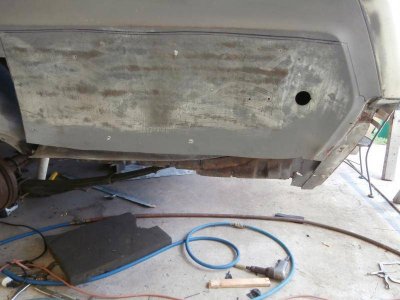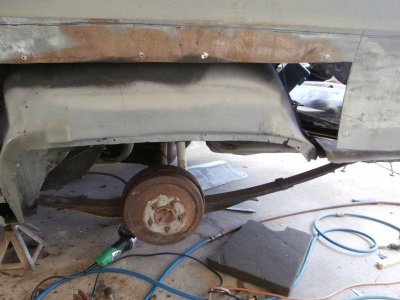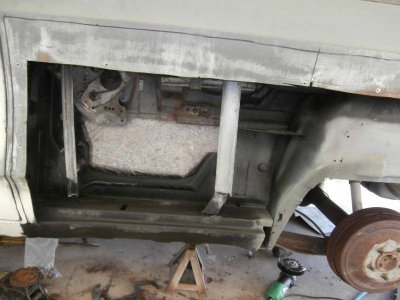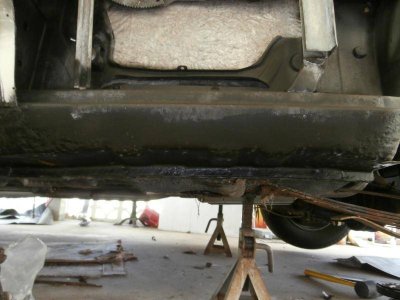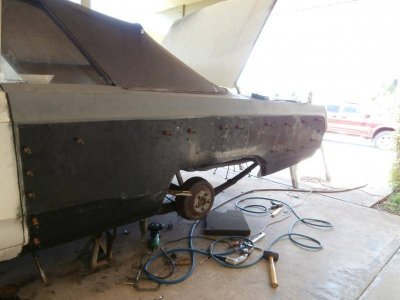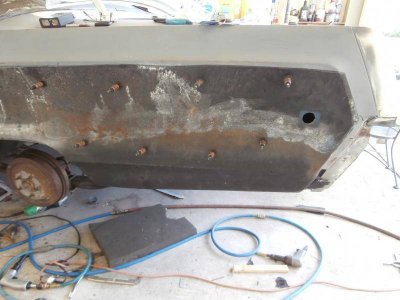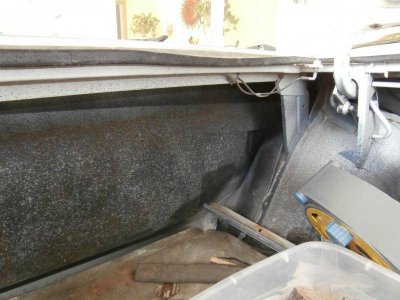You are using an out of date browser. It may not display this or other websites correctly.
You should upgrade or use an alternative browser.
You should upgrade or use an alternative browser.
Some help please:
- Thread starter bulldogchesty
- Start date
Wollfen
Old Man with a Hat
Personally I would use a length of two inch wide masking tape stuck on one end then held tight when pressing the entire length of it to the panel, then using a cutting blade to cut to the edge of the tape.
bulldogchesty
Senior Member
Thanks. That was what I was thinking. Wish me luck. I can always weld in more metal.
I were attempting to fit the panel the way you are. Once the panel is clamped in place as you have it. Use masking tape to create a straight line guide, staying about half inch inside the body line. Cut through both panels at the same time. This way you will have the exact cut on both pieces and they will fit together like a puzzle. I prefer to use a gig saw with a metal blade as to not heat the metal while cutting it. Heat is your enemy.
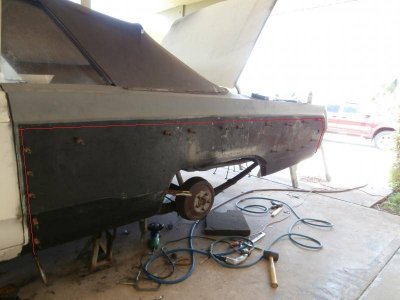


Last edited:
67Monaco
Go Woke, Go Broke.
Radius the corners, do not keep them 90 degree as you have them currently cut. The 90 will concentrate heat and will have a tendancy to burn back and you'll eventually dump way more heat into it than you need to trying to correct it.
Also, watch this video, Lazze has a very good tip for mating two panels.
Also, watch this video, Lazze has a very good tip for mating two panels.
Last edited by a moderator:
I would cut the two panels together too.
bulldogchesty
Senior Member
That looks like it would work for me Big_John. Thanks all.
MrMoparCHP
Old Man with a Hat
Why do you feel you need to make your cut straight? I see no reason you can't follow a body line.
I have used a body line as a reference and ran tape sized as needed to get the cut line where I needed it.
Alan
I have used a body line as a reference and ran tape sized as needed to get the cut line where I needed it.
Alan
cm23uoc
Old Man with a Hat
- Joined
- Feb 13, 2011
- Messages
- 8,369
- Reaction score
- 3,443
I think in this instance with such a Long cut I'd go with an overlapping weld personally and using a joggling tool to have the Joint smooth, to use minimal amount of lead or whatever you plan to use to fill the gap. For the overlapping area I'd use a welding primer to have suitable rust protection and spot weld the two pieces with a distance of about 20 Millimeters, something like a bit less than an Inch, sorry I was raised metric. 
Such a Long weld seam will brittle the metal and you have the danger of warpage as well that'll be hard to get out. But it has been done before.
Such a Long weld seam will brittle the metal and you have the danger of warpage as well that'll be hard to get out. But it has been done before.
Last edited:
78Brougham
"Chump"
I agree with CM23 that would make it brittle and warp. Maybe a "Punch and Flange" tool would work depending on where you cut the existing one. It works like a portable press that makes a flange that you lay the new piece on top of. The punch half is to make 5/16th hole in the new piece for spot welding. Its used primarily for floors but you never know. Astro Pneumatic is the manufacturer, the part number is 608PT. Might be worth a look
65sporty
Old Man with a Hat
I like 68Nwprts suggestion, I have seen it done this way works out good and leaves a small gap to butt weld, just go slow welding move your spot welds around until the whole panel is welded. Best of luck
bulldogchesty
Senior Member
Thanks for the help all. I'll keep you posted.
68blackbird
Active Member
Help?
I recently replaced both rear 1/4 panels on my 68 Firebird. One thing I did was once I had the new 1/4 clamped in place, I used weldable paint on the inside of the work to mark my line. I used a flange tool from HF and it made the job much easier. Once you get your piece cut, it lays in the flange and makes welding easy. If you don't already know this, make sure you are using gas with your welder, not fluxcore. Your welds will be muuuuch better if you do. This was my first attempt at this and it came out way better than I expected.
http://www.harborfreight.com/air-punch-flange-tool-1110.html
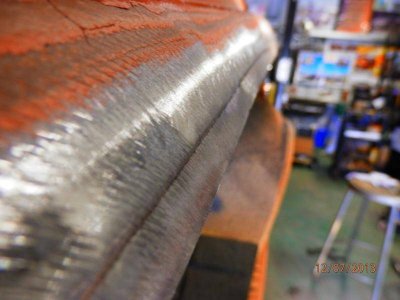
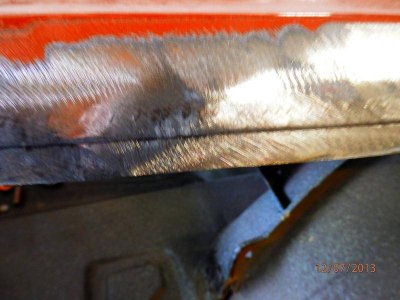
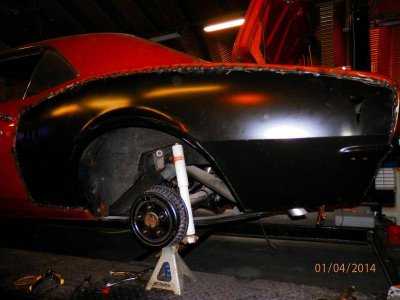



I recently replaced both rear 1/4 panels on my 68 Firebird. One thing I did was once I had the new 1/4 clamped in place, I used weldable paint on the inside of the work to mark my line. I used a flange tool from HF and it made the job much easier. Once you get your piece cut, it lays in the flange and makes welding easy. If you don't already know this, make sure you are using gas with your welder, not fluxcore. Your welds will be muuuuch better if you do. This was my first attempt at this and it came out way better than I expected.
http://www.harborfreight.com/air-punch-flange-tool-1110.html



commando1
Old Man with a Hat
I like the flange and overlap method myself. Much easier for hacks like me.
Yah, the inner side will be more prone to rust but I'm not worried about 25 years down the road.
Yah, the inner side will be more prone to rust but I'm not worried about 25 years down the road.
FWIW, the quarters were put on my 300 many years ago, 1990's at the earliest and the quarters were put on with a flanged seam. No rust issues at the seam what so ever.
There was some warping though and it cost me $ to have the body guy straighten it out properly.
My understanding is a butt weld is easier to straighten and keep from warping, but like anything else, it's all dependent on the skill and more importantly, patience of the guy welding the panel on.
So... I have nothing other then that to give. I've done enough paint and body work to know I hate doing it.
There was some warping though and it cost me $ to have the body guy straighten it out properly.
My understanding is a butt weld is easier to straighten and keep from warping, but like anything else, it's all dependent on the skill and more importantly, patience of the guy welding the panel on.
So... I have nothing other then that to give. I've done enough paint and body work to know I hate doing it.
The flange method seems like a good choice that I would like to try in the future. I've learned to keep the heat to a minimum after warping my first attempt at my rear deck filler. Also I've learned to stay away from a straight body line unless you have the skills to repair it. Good luck Dave. Much success to you!
cm23uoc
Old Man with a Hat
- Joined
- Feb 13, 2011
- Messages
- 8,369
- Reaction score
- 3,443
That's what I meant with the repair method I mentioned with the "joggling tool", that's what the dictionary spitted out. There won't be rust issues if a welding primer as mentioned is used. There are paste like ones available or spray on in rattle cans which are more like paint primer in consitency. The paste really starts to flow and seals even around the welding poits, the other one burns away a Little during welding process but welding is easier; I've used both types without any rust issues, some repairs two decades old.
Another Thing you may want to think about is that such repairs, back in the old days due to collision repairs according to the manufacturers usually only allowed These overlapping repairs, in most cases even giving exact cut lines for These partial repairs on unibodies to provide proper collapse of the repaired Panel in another Crash. But as mentione butt welds were done by others as well and it holds up as well.
Another Thing you may want to think about is that such repairs, back in the old days due to collision repairs according to the manufacturers usually only allowed These overlapping repairs, in most cases even giving exact cut lines for These partial repairs on unibodies to provide proper collapse of the repaired Panel in another Crash. But as mentione butt welds were done by others as well and it holds up as well.
bulldogchesty
Senior Member
Some more updates. I ran some blue inch tape from the body line on my car and then reinstalled my panel and ran another stripe of tape over the top of one first tape. I then removed the panel and cut both straight lines with my electric trimmer.I will post some pics. I think it turned out dam good, if I do say so myself.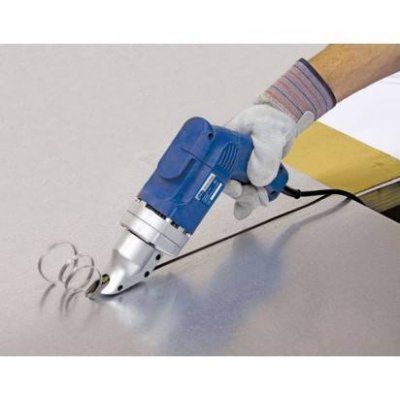


commando1
Old Man with a Hat
Me:


Similar threads
- Replies
- 8
- Views
- 893
- Replies
- 20
- Views
- 2K

